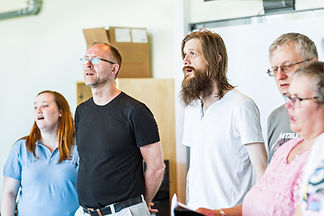


Sing to improve
your health!
”Sing Yourself Well” is a research-based
choral music initiative for people who
have challenges with their mental health.
Krafttak for sang and Nord Universitet are collaborating on the Sing yorself well-project in Norway. Today there are choirs in the cities of Fredrikstad, Kristiansand, Lillehammer og Namsos.
The research
The concept for a ”Sing Yourself Well” choir began to develop during a research project at North University in 2015, and builds on recovery as its professional basis. From April – June 2015, the researchers Grete Daling (Music director) og Arve Almvik (Project manager/health) interviewed participants in a research-choir to see weather their mental health . The method is ear-based and choir participants need no skill at singing or choir experience in advance. The exercises emphasizing to develop healthy and diverse voice use together with a varied repertoire.
Belonging and achieving
Through working with voice and singing together, the participants have an experience of pride, belonging and achievement. In addition, the choir provides a social community that supports and builds up the participants - even in times when they are facing difficulties.
A great potential for collaboration
North University sees great potential in cooperating across health services and the environments of culture and music. Compared to many other measures, a Sing Yourself Well-choir it is quite inexpensive for health services, and the psychosocial advantages are well documented.
Who can join the choir?
- People with mental health challenges
- People with any kind of diagnosis
- People with no singing experience
- People who do not necessarily sing clearly
- There are no admission requirements

Order the digital handbook!
The digital handbook consists of video-examples on how to best plan and execute a choir practise in accordance to the results of the research conducted by Nord University.
Learn how to control your breath and voice, working with pulse, coordination, rhythm and listening. The handbook also includes comments on the research behind each exercise.